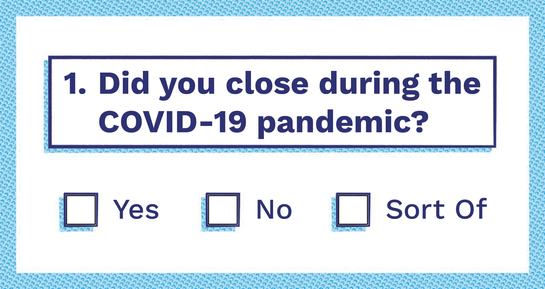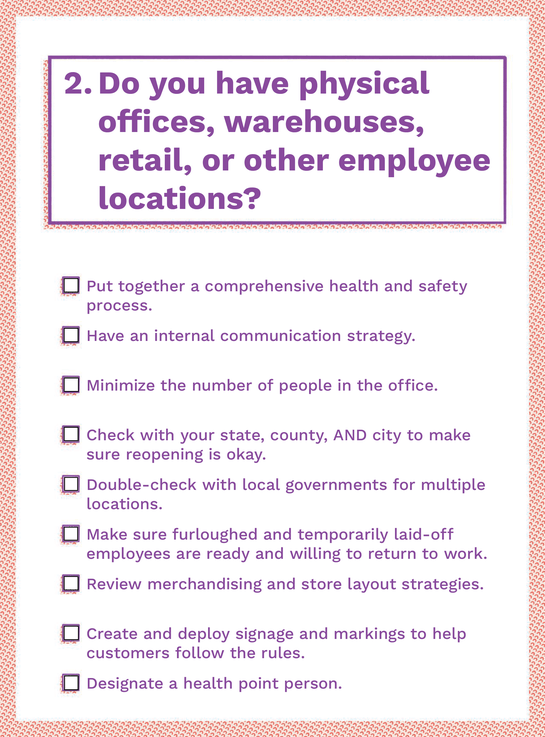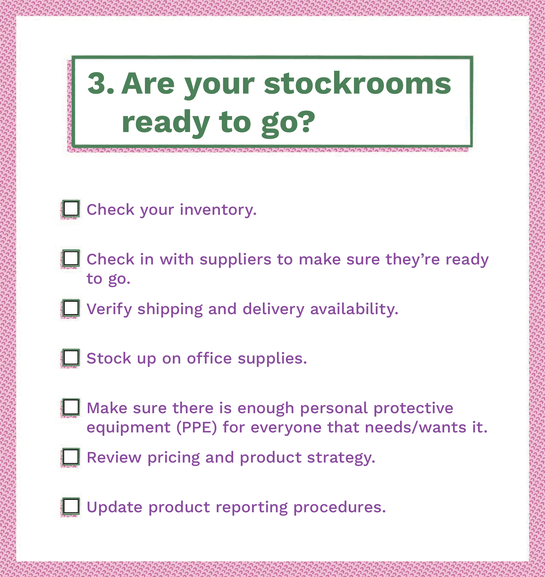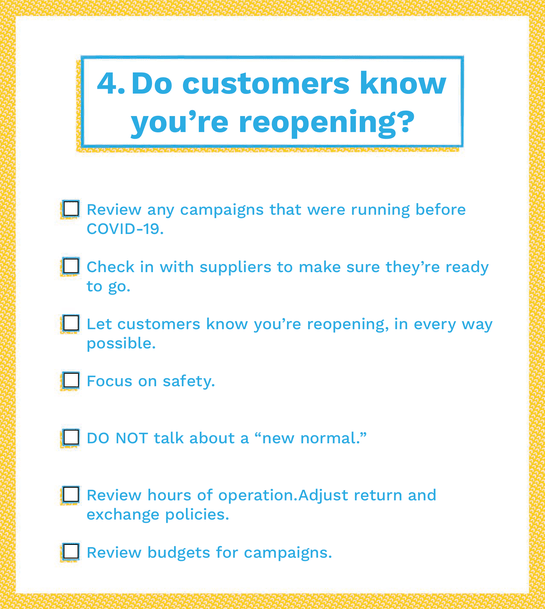With restrictions on businesses being at least partially lifted across the world, it’s time for companies to start thinking about what it’s going to take to reopen in the wake of the novel coronavirus pandemic. AdRoll has it covered — these hybrid checklists and in-depth explanations will guide brands through the process of getting ready to ramp up again, whether they shut their doors completely or just reduced operations.
![]()
- If you marked "Yes." Many brands completely shuttered operations while the pandemic was at its peak. These companies will have to pay the most attention during reopening, since they’ll likely have to worry about putting all-new processes into place and figuring out new ways of doing the things they’re used to doing.
- If you marked "No." Some brands were lucky enough to not face serious disruption. That doesn’t mean they should miss out on the reopening frenzy, though. As familiar brands are once again made available to consumers, companies that made inroads during the shutdown will have to work hard to maintain the visibility (and business) they’ve earned from customers over the last several weeks.
- If you marked "Sort of." Let’s face it — many brands, and most digital brands, fell into a grey area where they were open, but not all the way. This guide is especially useful for these companies, the ones that were still operating but working from home, or ones that shut down retail locations but kept e-commerce avenues running. These brands still need to develop new processes and procedures to deal with a post-COVID-19 world, but also have to fend off attacks from more established brands that are opening back up.
![]()
- Put together a comprehensive health and safety process. It might seem obvious, but the very first step is putting together a comprehensive set of procedures to keep workers safe. Make sure they cover all the basics — social distancing, groups and meetings, hygiene and cleanliness, health and wellness checks, and what employees should do if they suspect they might be coming down with something.
- Have an internal communication strategy. It’s not enough to have a great plan. It also needs to be communicated clearly and effectively to employees. Consider adding a COVID-19 advisory and health update to your regular all-hands meetings or updates.
- Minimize the number of people in the office. Let’s face it: some level of remote work is here to stay for a while. Consider doing rotating shifts, or otherwise minimizing the number of people on location at any given time. Some suggestions: split morning and evening shifts, stagger office days for different teams, or add additional office locations to break up staff.
- Check with your state, county, AND city to make sure reopening is okay. One of the most frustrating aspects of the shutdown has been the disconnect between the various levels of government. Take a company based in Miami, for example: they would currently be under three separate executive shutdown orders — one from the City of Miami, one from Miami-Dade County, and one from the state of Florida. Check top to bottom to make sure that reopening is safe and legal, and make sure to verify status for different kinds of employee settings. Some locations are allowing office workers, but not warehouse workers. Others are opening restaurants, but not retail.
- Double-check with local governments for multiple locations. This is especially true for companies with retail locations. Two stores a block apart might have drastically different reopening requirements, just because the city line runs down the middle of the street. Get as detailed a list of requirements and regulations as possible, and make sure that each location has a plan to reopen that fits.
- Make sure furloughed and temporarily laid-off employees are ready and willing to return to work. Not everyone is ready to jump back into things, and despite record unemployment, many people report that they aren’t yet comfortable going back to work. Check employees to gauge their readiness levels, and try to identify solutions to make them feel more comfortable returning to the office, storefront, or restaurant. Not all will want to, so make sure there is a plan to hire replacements to ensure that the business can run smoothly.
- Review merchandising and store layout strategies. Consumers will have social distancing on their minds for the foreseeable future. Make sure that every retail location is set up to allow it. Consider changing merchandise and store layouts to keep people from crowding.
- Create and deploy signage and markings to help customers follow the rules. Not everyone that walks into a store is going to be familiar with social distancing guidelines. Make sure that there is clear, highly-visible signage to let them know what’s expected. Marking the floor with tape six feet apart can also help.
- Designate a health point person. Who’s in charge of making sure policies and procedures are followed? Without a point person, the answer is “no one," and that usually means the rules go out the window. Designate someone (or some people) at every location, and empower them to clarify and enforce the rules.
![]()
- Check your inventory. Who knows what the stockroom looks like after two months of sitting unused? Do a thorough inventory and adjust as needed to deal with the new realities of a post-COVID-19 economy.
- Check in with suppliers to make sure they’re ready to go. Just because one company is reopening doesn’t mean every company in their supply chain is. A big issue during the shutdowns has been finding suppliers, so before committing to reopening, check in to make sure that products and materials are available.
- Verify shipping and delivery availability. While we’re past the point where shippers deprioritized non-essential supplies, shipping, and delivery services are still dealing with chaotic conditions. Check to make sure materials can get to your production facilities, and finished products can get to stores and customers.
- Stock up on office supplies. Things are going to remain… “fluid” for quite some time. When rebuilding stock, consider stocking up with some extra back-office supplies. Receipt paper, toilet paper, cleaning supplies — all of these essential supply chains are still up in the air, so get enough to last in case of missed shipments.
- Make sure there is enough personal protective equipment (PPE) for everyone that needs/wants it. As businesses open back up, things like face masks and sanitizers might once again come into short supply. Make sure that there is enough on hand to last and to be provided for everyone that either requires it or simply wants some to feel more secure.
- Review pricing and product strategy. Things have changed, and the products that sold like hotcakes might not be what consumers are looking for right now. Check pricing and product to make sure that the things being sold are the things consumers are buying, and at the right price.
- Update product reporting procedures. The biggest certainty in this reopening is that things will stay uncertain for a while. Brands should be reporting on sales more regularly, and reviewing reports more carefully, to make sure that they stay on top of rapidly shifting trends.
![]()
- Review any campaigns that were running before COVID-19. Some might be ready to turn back on. Some might be inappropriate or ineffective in a post-coronavirus world. Do a full review of all campaigns before flipping the switch.
- Make sure seasons are still a thing. Not literally, but do seasonal campaigns still make sense? For example, it might not be the best time to run ads promoting Fourth of July parties. Before returning to traditional seasonal campaigns, make sure that they still fit consumer moods and wants.
- Let customers know you’re reopening, in every way possible. This is the time for omnichannel. Not in the buzzword-y, marketing-speak way, but in the sense that customers are about to be bombarded with messaging about reopening. Add in the very real ways that consumer behavior and media consumption has changed during the pandemic, and it’s critical for brands to get their message out across every channel possible. Look to email, social, advertising, but also consider the less glamorous approaches of physical mail, big signage, even billboards!
- Focus on safety. Consumers are by and large still worried about their health and safety. Make sure any reopening announcements make clear that those worries are top of mind for brands, and that they are being addressed.
- DO NOT talk about a “new normal.” Just don’t. Consumers don’t want a new normal. They want the old normal back. Even when they realize that things cannot go back to how they were, they don’t want to be reminded about it. Talk about a cautious return to the old normal, not a new way of doing things.
- Review hours of operation. Some locations will need to stay open longer to accommodate customers at a more limited occupancy rate. Some will have to close earlier to make sure the location can be cleaned and sanitized. Whatever the case, review hours of operation and make sure the new hours are clearly communicated to customers.
- Adjust return and exchange policies. Most consumers don’t want to spend any more time in public than they have to. Make it easier to return or exchange items, and consider adding mail-in returns for items purchased in physical stores. At the same time, make sure there is a clear set of guidelines for ensuring returned items are cleaned and sanitized before returning to inventory.
- Review budgets for campaigns. While so many companies were closed, advertising rates have shifted. Make sure that budgets still make sense to reach the desired number of customers. For brands that haven’t shifted to activity-based reporting, this is the time to do so — focusing on views, visitors, and other intermediate metrics isn’t going to give a good picture of how effective advertising is in a climate where people have lots of time to browse, but are still nervous about spending money.
Check out our D2C Shopping List — you won't want to miss the goodies we have lined up for you.
Last updated on April 23rd, 2025.




